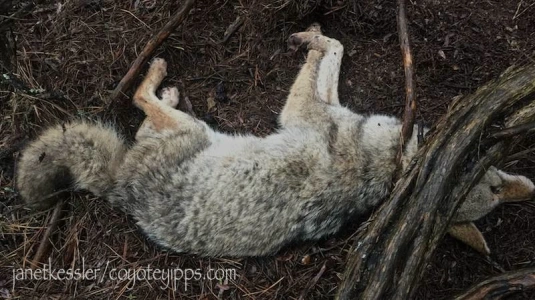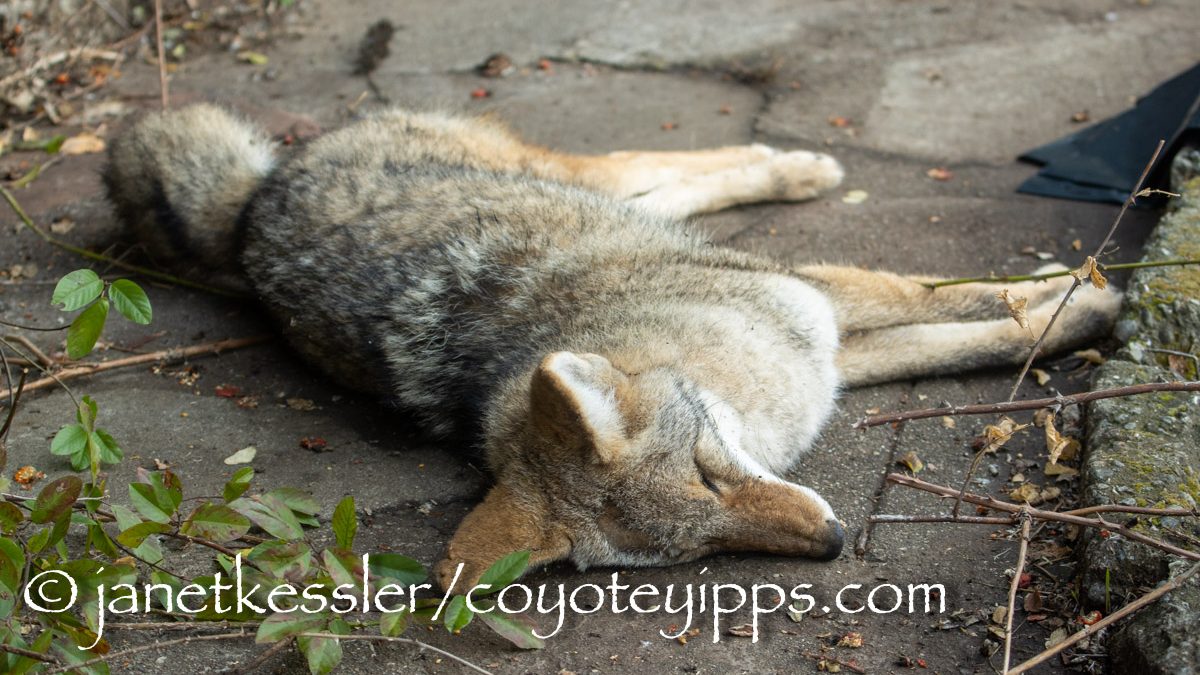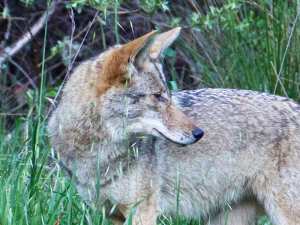
killed by rat poison
My friend found her, having been led there by her dog, CC, who is an incredibly inquisitive, active explorer, even on-leash. And my friend lets her dog lead the way. This time she was lead to where a dead coyote lay hidden in the bushes. My friend knew it was a canid, but when she wrote me about it, she referred to it as a *creature*, knowing that a coyote death would upset me, especially where I knew all the coyotes.
She told me its general location and sent me a photo showing tree branches. I was able to find the coyote because of the photo. The type of tree under which the coyote lay would be found only in a certain area. That is the area I searched until I found the critter. I was crushed when I first saw it. It was a young coyote with very ruffled and light colored fur — I’ve seen yearlings with this coloring. This coyote must have recently dispersed from another area, because she was not from the territory in which she had been found. I know those coyotes well, and this one was not one of them, and I had not seen her ever before.
She was wedged in there, held in by a broken branch poking into her neck. It was a tangle of branches, and I had to bend over, and go over and under, being careful to avoid getting branches in my face. I wondered if this animal might have become trapped there, but I was able to move this branch without too much effort, so probably not. On the other side of the tree limb which she was under, her face could be seen with the eye facing up being opened. It was a gorgeous blue. Young coyotes often have blue eyes.
Most coyotes in cities are killed by cars, but this coyote was found right in the middle of a park, past the backyards of a row of houses, not close to any streets, so she probably would not have been hit by a car. I didn’t see any trauma to her body.
What to do? I thought about it only a moment and decided on a necropsy. Those on the sidewalk watching me were very happy about this decision. We all wanted to know what had killed this coyote. I walked to a store which was only 2 minutes away to get 55 gallon bags. I was able to bag the coyote by pushing it into the large bag with another smaller plastic bag over my hand. A man who was there offered to carry it to the car. This young coyote must have weighed a mere 25 pounds at most.
I got home and called Wildcare, and after some back and forth conversation, my husband drove me up to San Rafael where Wildcare is located. Initially they did an X-ray which showed a VERY full stomach. But there was no trauma to the body — no broken bones or ribs. What could have killed her?
Several weeks later, I was called with the results of the necropsy report: She had died of massive internal bleeding due to rat poisoning. There were actually four different types of rat poisons found in her liver, with the highest poison concentration being Bromadiolone, so she had eaten bad rats from at least four sources, and she may have eaten the poison pellets herself. Each brand of rat poison only carries ONE of the poisons. Different people buy different brands. This shows that many people in the area are using rat poisons. Wildcare is finding rat poison in most of the animals it treats — isn’t this incredible? I’ll be working with Wildcare to help get information out about poisons — and hopefully folks will become aware of the harm poisons cause to our wildlife, and hopefully they’ll stop using them.
PLEASE TALK TO YOUR NEIGHBORS, FRIENDS AND COLLEAGUES AND ASK THEM NEVER TO USE RAT POISON — EVER!
[see May writeup in Noe Valley Voice]

killed by rat poison










